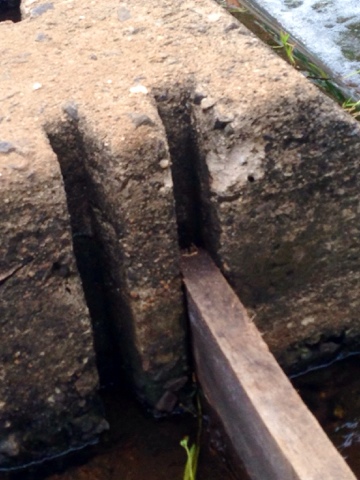The inspiration for my upcoming Fulbright is the analysis of intangibles in the Sri Lankan landscape. In earlier posts I've written about lots of examples but a kind of "big one" has been on my mind that I keep putting off. I discussed it briefly with my artist-designer friend Gihan Karunaratne, one of the most creative thinkers I know. I hope I'll be able to take lots of pictures of it in the field and persuade busy Gihan to visit the National Museum in Colombo to study some examples. You may be wondering what I'm talking about.
When I visited the rural North Central Province of Sri Lanka in May I saw lots of examples. Using all kinds of materials, but especially wood and stone, the ancient Lankans employed all kinds of slots and grooves in their effort to tame, direct, control, and store water. The slots and groves and the planks that fit into them weren't exactly obvious during my forays. They were the kind of landscape feature that I really love, the feature that is hidden in plain sight.
What do these design forms tell us about their makers? For one thing they introduce us to the intentionality of the people who built and used them. They are assuredly cut, well-measured and executed. They show a confident mastery of materials, as well as an understanding of water, the material they were meant to interact with. Perhaps most interesting is their simplicity. That simplicity is a kind of bespoke response of solid materials to their fluid partner, water, slightly different in each example. The stark contrast between messy water and the built, carved, and planed materials it encounters is remarkable.
The slots, grooves, and planks are also unusual in that they constitute a hard element in a soft landscape. Nothing is softer it seems than the lazy ponds of the tanks covered in lotuses. But that landscape was created by the application of hard materials to it, materials used to establish the bunds, sluice the water, and direct it into beneficial streams.
How were these techniques used in other building situations? We know for example that features of the bunds such as their curvature and angle of repose was applied to the construction of dagobas all over Sri Lanka. These are as much in evidence across the island as the ancient, carefully finished granite pillars of extinct temples, pillars that are as beautifully dressed as any 19th century granite work we can find in New England.
All this speaks to an advanced design ensemble based on a few simple but effective shapes. Something like a Mozart sonata or a Bach cantata, a few notes go far in explaining a richness of sound. Our Sri Lankan example of slots and grooves takes us to the same aesthetic heights on the broad shoulders of practicality. It is the epitome of agricultural design.








No comments:
Post a Comment